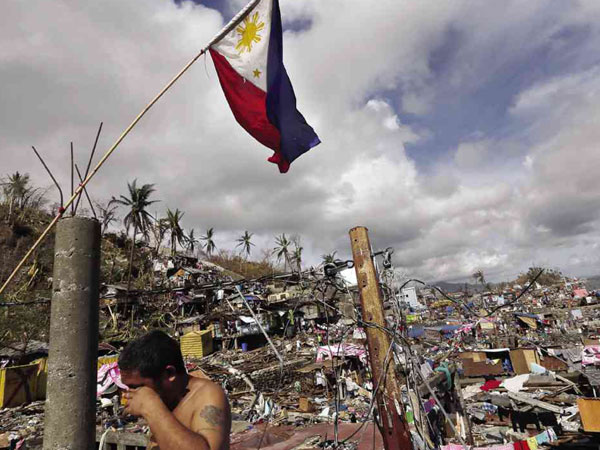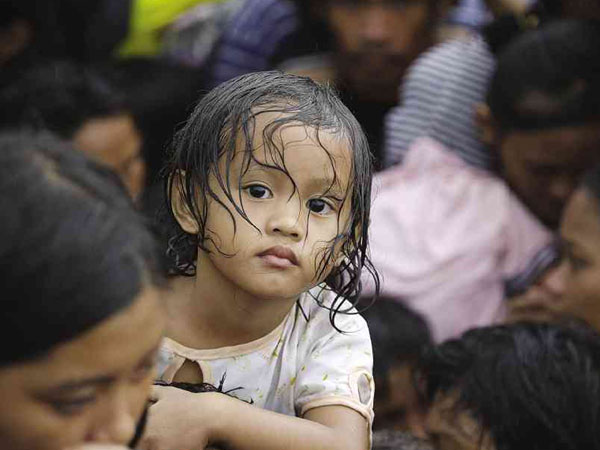Logjam in aid delivery

FLAG RAISED IN DEVASTATED LAND A survivor wipes his face before a Philippine flag in typhoon-ravaged Tacloban, a city short of food and water, and littered with countless bodies. AP
TACLOBAN CITY—A day after Supertyphoon “Yolanda” struck the eastern Philippine coast, a team of 15 doctors and logistics experts was ready to fly to the worst-hit city to help. On Tuesday, five days into what could be the country’s deadliest disaster, they were still waiting to leave.
Aid is coming to Tacloban: medical supplies, pallets of water and food piled on trucks, planes and ferries, sent by the Philippine government and countries around the world.
But the scale of the disaster and challenges of delivering the assistance means few in this city, strewn with debris and corpses, have received any help.
A team from Médecins Sans Frontières (Doctors Without Borders), complete with medical supplies, arrived in Cebu City on Saturday looking for a flight to Tacloban, but hadn’t left by Tuesday.
A spokesperson for the group said it was “difficult to tell” when it would be able to leave.
Article continues after this advertisement“We are in contact with the authorities, but the (Tacloban) airport is only for the Philippine military use,” Lee Pik Kwan said in a telephone interview.
Article continues after this advertisementAt the medical group’s intended destination, thousands of typhoon victims were trying to get out. They camped at the airport and ran onto the tarmac when planes came in, surging past a broken iron fence and a few soldiers and police trying to control them. Most didn’t make it aboard.
“We need help. Nothing is happening,” said Aristone Balute, an 81-year-old who didn’t get on a flight out of the city. “We haven’t eaten since yesterday afternoon.” Her clothes were soaked from the rain, and tears streamed down her face.
“There’s a bit of a logjam to be absolutely honest getting stuff in here,” said United Nations staffer Sebastian Rhodes Stampa against the roar of a C-130 plane landing behind him at the airport here.
“It’s almost all in country, either in Manila or in Cebu, but it’s not here. We’re going to have real challenge with logistics in terms of getting things out of here, into town, out of town, into the other areas,” he said.
“The reason for that essentially is that there are no trucks, the roads are all closed,” he said.
No food
“We survived the storm, but there’s no food,” Brendo Gamez, mayor of Abon-Abon town, said on Tuesday night.
Where is the food? Where is the water?
Gamez, Julita Mayor Irvin Dy and Tanauan Mayor Pel Tecson went to the Tacloban airport to see for themselves that the relief promised by the national government had been loaded on military trucks and would be delivered to their towns.
“We have not done enough. There is a need to scale up the effort,” Valerie Amos, chief of the United Nations Humanitarian Assistance Office, told the Inquirer.
“While we have done all, at the same time there is more that we should have been able to do,” she said.
No organization
An Associated Press reporter drove through the town for around 7 kilometers on Tuesday and saw more than 40 bodies. He saw no evidence of any organized delivery of food, water or medical supplies, though piles of aid have begun to arrive at the airport.
Some people were lining up to get water from a hose, presumably from the city supply.
“There is a huge amount that we need to do. We have not been able to get into the remote communities,” Amos said.
“Even in Tacloban, because of the debris and the difficulties with logistics and so on, we have not been able to get in the level of supply that we would want to. We are going to do as much as we can to bring in more,” she added.
Defense Secretary Voltaire Gazmin acknowledged that the relief, while not wanting, was only trickling down to the survivors.
Gazmin said he himself was at a loss to explain where the bottleneck was.
“There is something wrong with the system,” Gazmin said. “I don’t know how to put it, but we have been doing our part of bringing supplies from the national government to the local governments. Somehow, somewhere along the line, some (local governments) or some of the barangays (villages) are left out. I don’t know for what reason.”
Gazmin suggested it could be the absence of communications in the first few days after the storm, but said things were now getting better organized and relief could begin to be sent where they were needed most.
In Malacañang, Cabinet Secretary Jose Rene Almendras raised the possibility that some survivors were complaining because of “political considerations.”
“To be frank, I was also getting reports that one of the reasons why there are people who say that they’re still not receiving [relief] and yet know that there have already been deliveries to some of those areas is there seems to be a political consideration,” Almendras said, but did not elaborate.
Julita’s Mayor Dy said the local governments were prepared, but no one was prepared for the ferocity of the storm.
“We were prepared. Locally we were ready. But even our relief [supplies] were washed out,” he said.
Desperate for medicine
Doctors in Tacloban said they were desperate for medicine.
Beside the ruined airport tower, at a small makeshift clinic with shattered windows, Philippine Army and Philippine Air Force medics said they had treated around 1,000 people for cuts, bruises, lacerations and deep wounds.
“It’s overwhelming,” said Air Force Capt. Antonio Tamayo. “We need more medicine. We cannot give antitetanus vaccine shots because we have none.”
The longer survivors go without access to clean water, food, shelter and medical help, the greater chance of disease breaking out and people dying as a result of wounds sustained in the storm.
The official death toll from the disaster rose to 2,200 on Wednesday, though authorities have said they expect that to rise markedly.
They fear estimates of 10,000 dead are accurate and might be low.
More than 9 million people have been affected across a large swath of the country, many of them made homeless.
City in ruins
Tacloban, a city of about 220,000 people, bore the full force of Yolanda’s winds and the tsunami-like storm surges.
Most of the city is in ruins, a tangled mess of destroyed houses, cars and trees.
Malls, garages and shops have all been stripped of food and water by hungry residents.
The loss of life appears to be concentrated in Tacloban and surrounding areas, including a portion of Samar island that is separated from Leyte island by a strait.
It is possible that other devastated areas are so isolated they have not yet been reached.

CHILD SEEKING FLIGHT OUT A child waits in the rain with fellow typhoon survivors as they line up in hopes of boarding a C-130 plane in Tacloban City. Thousands have swarmed the airport, seeking a flight out but only a few hundred have made it. BULLIT MARQUEZ/AP
Air Force works
In Cebu, the Philippine Air Force has been sending three C-130s back and forth to Tacloban from dawn to dusk, and had delivered 212,000 kilos of relief supplies by Tuesday, according to Lt. Col. Marciano Jesus Guevara.
The Philippine Navy is also carrying relief, with the BRP Bacolod City, leaving Bohol on Tuesday with 188 tons of supplies for Tacloban.
Public Works Secretary Rogelio Singson on Wednesday said that the government had been providing 140,000 food packs daily to survivors in Tacloban.
Singson told a news conference that the Department of Public Works and Highways and the National Housing Authority were also “preparing to put up temporary shelters” for the survivors.
Asked how many, Singson said, “Quite a lot.”
He said the Department of Social Welfare and Development and other agencies would find resettlement sites where the temporary shelters, mostly tents, could be set up.
No government help
“There is no help coming in. They know this is a tragedy. They know our needs are urgent. Where is the shelter?” said Aristone Balute’s granddaughter, Mylene, who was also at the airport. “We are confused. We don’t know who is in charge.”
Damaged roads and other infrastructure are complicating the relief efforts.
Government officials and police and Army officers are in many cases among the victims themselves, hampering coordination.
The typhoon destroyed military buildings that housed 1,000 soldiers in Leyte province.
At Matnog, the Sorsogon port for ferries leaving to Samar island, dozens of trucks piled high with aid were waiting to cross.
In Manila, soldiers tossed pallets of water, medical supplies and foods into C-130 planes bound for the disaster area.
More than 600,000 people were in evacuation centers in Western Visayas as of Wednesday, with the death toll in the region rising to 233—162 in Iloilo, 50 in Capiz, 11 in Aklan and 10 in Antique—according to the Iloilo provincial disaster council.
UN help
The United Nations said it had released $25 million in emergency funds to pay for emergency shelter materials and household items, and for assistance with the provision of emergency health services, safe water supplies and sanitation facilities. It is launching an appeal for more aid.
The aircraft carrier USS George Washington is headed toward the region with massive amounts of water and food, but the Pentagon said it won’t arrive until Thursday.
The United States also said it is providing $20 million in immediate aid.
Aid totaling tens of millions of dollars has been pledged by many other countries, including Japan, Australia and Britain, which is sending a Royal Navy vessel with aid.
Lucky few
For now, relief has come to a lucky few, including Joselito Caimoy, a 42-year-old truck driver. He was able to get his wife, son and 3-year-old daughter on a flight out of Tacloban. They embraced in a tearful goodbye, but Caimoy stayed behind to guard what’s left of his home and property.
“People are just scavenging on the streets. People are asking food from relatives, friends. The devastation is too much … the malls, the grocery stories have all been looted,” he said. “They’re empty. People are hungry. And they (the authorities) cannot control the people.”
The dead, decomposing and stinking, litter the streets or remain trapped in the debris.—Reports from Nikko Dizon, Jerry E. Esplanada, Christian V. Esguerra and Kristine Felisse Mangunay in Manila; Nestor P. Burgos, Inquirer Visayas; and AP